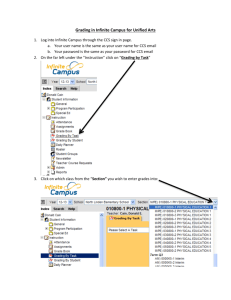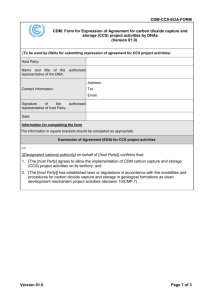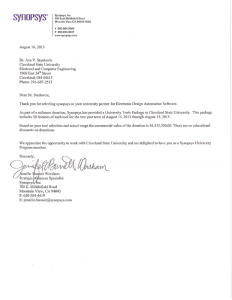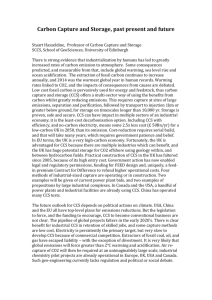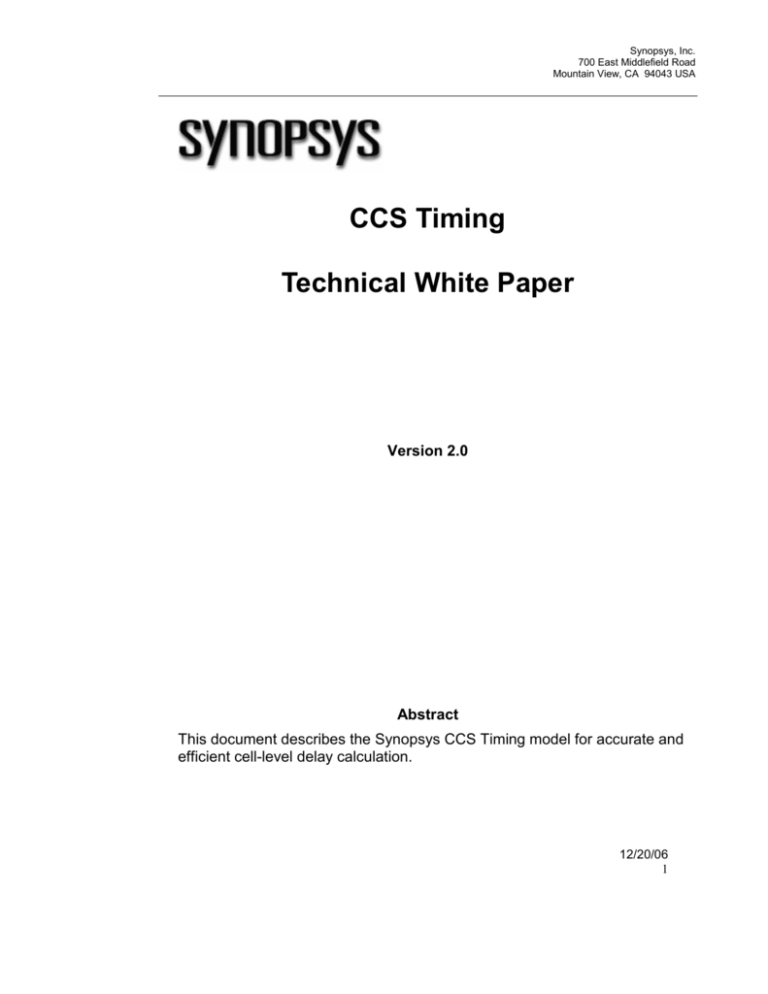
Synopsys, Inc.
700 East Middlefield Road
Mountain View, CA 94043 USA
CCS Timing
Technical White Paper
Version 2.0
Abstract
This document describes the Synopsys CCS Timing model for accurate and
efficient cell-level delay calculation.
12/20/06
1
Synopsys, Inc.
700 East Middlefield Road
Mountain View, CA 94043 USA
Copyright Notice and Proprietary Information
Copyright © 2005 Synopsys, Inc. All rights reserved. This software and documentation contain confidential and
proprietary information that is the property of Synopsys, Inc. The software and documentation are furnished under a
license agreement and may be used or copied only in accordance with the terms of the license agreement. No part of
the software and documentation may be reproduced, transmitted, or translated, in any form or by any means, electronic,
mechanical, manual, optical, or otherwise, without prior written permission of Synopsys, Inc., or as expressly provided by
the license agreement.
Right to Copy Documentation
The license agreement with Synopsys permits licensee to make copies of the documentation for its internal use only.
Each copy shall include all copyrights, trademarks, service marks, and proprietary rights notices, if any. Licensee must
assign sequential numbers to all copies. These copies shall contain the following legend on the cover page:“This
document is duplicated with the permission of Synopsys, Inc., for the exclusive use
of__________________________________________ and its employees. This is copy number __________.”
Destination Control Statement
All technical data contained in this publication is subject to the export control laws of the United States of America.
Disclosure to nationals of other countries contrary to United States law is prohibited. It is the reader’s responsibility to
determine the applicable regulations and to comply with them.
Disclaimer
SYNOPSYS, INC., AND ITS LICENSORS MAKE NO WARRANTY OF ANY KIND, EXPRESS OR IMPLIED, WITH
REGARD TO THIS MATERIAL, INCLUDING, BUT NOT LIMITED TO, THE IMPLIED WARRANTIES OF
MERCHANTABILITY AND FITNESS FOR A PARTICULAR PURPOSE.
Registered Trademarks (®)
Synopsys, AMPS, Arcadia, C Level Design, C2HDL, C2V, C2VHDL, Cadabra, Calaveras Algorithm, CATS, CSim,
Design Compiler, DesignPower, DesignWare, EPIC, Formality, HSPICE, Hypermodel, I, iN-Phase, in-Sync, Leda,
MAST, Meta, Meta-Software, ModelAccess, ModelTools, NanoSim, OpenVera, PathMill, Photolynx, Physical Compiler,
PowerMill, PrimeTime, RailMill, Raphael, RapidScript, Saber, SiVL, SNUG, SolvNet, Stream Driven Simulator, Superlog,
System Compiler, Testify, TetraMAX, TimeMill, TMA, VCS, Vera, and Virtual Stepper are registered trademarks of
Synopsys, Inc.
Trademarks (™)
abraCAD, abraMAP, Active Parasitics, AFGen, Apollo, Apollo II, Apollo-DPII, Apollo-GA, ApolloGAII, Astro, Astro-Rail,
Astro-Xtalk, Aurora, AvanTestchip, AvanWaves, BCView, Behavioral Compiler, BOA, BRT, Cedar, ChipPlanner, Circuit
Analysis, Columbia, Columbia-CE, Comet 3D, Cosmos, CosmosEnterprise, CosmosLE, CosmosScope, CosmosSE,
Cyclelink, Davinci, DC Expert, DC Expert Plus, DC Professional, DC Ultra, DC Ultra Plus, Design Advisor, Design
Analyzer, Design Vision, DesignerHDL, DesignTime, DFM-Workbench, DFT Compiler, Direct RTL, Direct Silicon
Access, Discovery, DW8051, DWPCI, Dynamic-Macromodeling, Dynamic Model Switcher, ECL Compiler, ECO
Compiler, EDAnavigator, Encore, Encore PQ, Evaccess, ExpressModel, Floorplan Manager, Formal Model Checker,
FoundryModel, FPGA Compiler II, FPGA Express, Frame Compiler, Galaxy, Gatran, HDL Advisor, HDL Compiler,
Hercules, Hercules-Explorer, Hercules-II, Hierarchical Optimization Technology, High Performance Option, HotPlace,
HSPICE-Link, iN-Tandem, Integrator, Interactive Waveform Viewer, i-Virtual Stepper, Jupiter, Jupiter-DP, JupiterXT,
JupiterXT-ASIC, JVXtreme, Liberty, Libra-Passport, Library Compiler, Libra-Visa, Magellan, Mars, Mars-Rail, Mars-Xtalk,
Medici, Metacapture, Metacircuit, Metamanager, Metamixsim, Milkyway, ModelSource, Module Compiler, MS-3200, MS3400, Nova Product Family, Nova-ExploreRTL, Nova-Trans, Nova-VeriLint, Nova-VHDLlint, Optimum Silicon, Orion_ec,
Parasitic View, Passport, Planet, Planet-PL, Planet-RTL, Polaris, Polaris-CBS, Polaris-MT, Power Compiler,
PowerCODE, PowerGate, ProFPGA, ProGen, Prospector, Protocol Compiler, PSMGen, Raphael-NES, RoadRunner,
RTL Analyzer, Saturn, ScanBand, Schematic Compiler, Scirocco, Scirocco-i, Shadow Debugger, Silicon Blueprint,
Silicon Early Access, SinglePass-SoC, Smart Extraction, SmartLicense, SmartModel Library, Softwire, Source-Level
Design, Star, Star-DC, Star-MS, Star-MTB, Star-Power, Star-Rail, Star-RC, Star-RCXT, Star-Sim, Star-SimXT, StarTime, Star-XP, SWIFT, Taurus, Taurus-Device, Taurus-Layout, Taurus-Lithography, Taurus-Process, TaurusTopography, Taurus-Visual, Taurus-Workbench, TimeSlice, TimeTracker, Timing Annotator, TopoPlace, TopoRoute,
Trace-On-Demand, True-Hspice, TSUPREM-4, TymeWare, VCS Express, VCSi, Venus, Verification Portal, VFormal,
VHDL Compiler, VHDL System Simulator, VirSim, and VMC are trademarks of Synopsys, Inc.
Service Marks (SM)
MAP-in, SVP Café, and TAP-in are service marks of Synopsys, Inc.
SystemC is a trademark of the Open SystemC Initiative and is used under license.
ARM and AMBA are registered trademarks of ARM Limited.
All other product or company names may be trademarks of their respective owners.
Printed in the U.S.A.
12/20/06
2
Synopsys, Inc.
700 East Middlefield Road
Mountain View, CA 94043 USA
1 Introduction
Accurate delay calculation is critical for timing closure of complex digital
designs. At 90nm and below, physical effects and design styles present
new challenges for delay calculation. Top-level interconnect is becoming
more resistive with narrower metal widths, resulting in cases where the
interconnect impedance is much greater than the drive resistance of the
driving cell. Analysis is needed across a wide range of Vdd values to
support dynamic IR drop effects, and low-power design styles including
voltage islands and dynamic voltage/frequency scaling. Inverted
temperature dependence at low voltages requires analysis at
intermediate temperature values.
A delay model is needed that enables accuracy close to circuit
simulation, but with fast calculation to support flat analysis of the largest
designs. The model must support calculation of cell delay, interconnect
delay, pin slew (also called “transition time”) and input pin capacitance for
stages including detailed parasitics. This paper describes Synopsys’
Composite Current Source model for timing (CCS Timing) which
addresses these needs and future delay calculation needs.
Delay calculation is performed for one stage at a time, where a stage
consists of the driving cell arc, the output RC network, and the
capacitance of the network load pins. The goal is to compute the
response at the driver output and at the network load pins, given an input
slew or waveform at the driver input, as shown in Figure 1. The
computed responses are then used to determine the cell delay for the
driver and the input slews at the load pins.
12/20/06
3
Synopsys, Inc.
700 East Middlefield Road
Mountain View, CA 94043 USA
Compute response at these pins
Sinp
Figure 1: Stage Delay Calculation
To perform stage delay calculation efficiently, three models are created:
the driving cell arc is replaced by a driver model; the interconnect RC
network is replaced by a reduced order model, such as Block Arnoldi;
and the load pins are replaced by a receiver model (see Figure 2).
Driver
Model
Arnoldi Reduced-Order
Model
Receiver
Model
Receiver
Model
Receiver
Model
Figure 2:The
Stagedriver
represented
driverbe
model,
and receiverthe
models
modelbymust
ableROM
to reproduce
response
of the cell’s
underlying transistor circuitry when connected to an arbitrary RC network
Note that the receiver model must represent the complex input
capacitance of a cell input pin. The transistors do not present a constant
input capacitance to a driver. The equivalent capacitive load (from I = C *
12/20/06
4
Synopsys, Inc.
700 East Middlefield Road
Mountain View, CA 94043 USA
dv/dt) can vary depending on the rise/fall direction of the transition, the
input slew at the pin, the output load, and the state of the cell. In
addition, this capacitance can change during the transition. The receiver
model must be able to represent all these effects.
2 Previous Approaches
2.1
Thevenin and Norton Models
Previous driver models used either a time-dependent voltage source in
series with a resistor (Thevenin model) or a time-dependent current
source in parallel with a resistor (Norton model). The resistor in those
models is typically referred to as the “drive resistor” and is used to
express the timing arc’s sensitivity to output capacitance, whereas the
waveform shape itself is primarily expressed by the voltage or current
source.
Refinements to these models to account for complex aspects of transistor
behavior have typically dealt with making the time-dependent nature of
the voltage/current source more complex. Other approaches have dealt
with multiple drive resistances and arbitrary dynamic impedances.
Figure 3: The Rd << Znet problem. (a) shows a transistor circuit driving a detailed parasitic
network at node ‘B’. (b) The network presents an impedance Znet to the Thevenin driver model.
When Rd << Znet, Vout approaches Vin and the driver model can lose accuracy.
12/20/06
5
Synopsys, Inc.
700 East Middlefield Road
Mountain View, CA 94043 USA
Unfortunately, there is a major limitation when conventional models are
used to drive an interconnect network with an impedance Znet much
greater than the drive resistance Rd. Consider the Thevenin model
driving a detailed parasitic network as shown in Figure 3. Note that the
circuit forms a voltage divider with
Vout
Znet
V = R +Z
in
d
net
which approaches unity when Rd<<Znet. This indicates that a driver
model based upon a drive resistance (or arbitrary impedance) that is set
independent of the network load will be ineffective in this regime.
Since the transistor behavior deviates from the Thevenin voltage source
nearest the power rails, this situation is typically worst when the network
delay is greater than the output transition time.
2.2
Previous Receiver Models
The traditional receiver model is a single value of capacitance for an input
pin. More recently, separate values have been allowed for rising vs.
falling transitions, and a min/max range has been introduced that can
bind the complex capacitance effects, but which leads to pessimism
during analysis.
Using a single capacitance value for the entire transition results in
inaccuracy for single-stage cells where the Miller effect is significant,
affecting the calculation of both cell delay and slew. Figure 4 shows that
the voltage waveform for the input of a single-stage cell, such as an
inverter, cannot be approximated well by any single capacitance value.
12/20/06
6
Synopsys, Inc.
700 East Middlefield Road
Mountain View, CA 94043 USA
Figure 4: A single capacitance value is insufficient when Miller effect is large
3 The CCS Timing Solution
CCS Timing consists of a driver model and a receiver model. The driver
model describes how a timing arc propagates a transition from input to
output, and how it can drive arbitrary RC networks. The receiver model
describes the capacitance that an input pin presents to driving cells.
The CCS Timing driver model is a time and voltage dependent current
source with an essentially infinite drive-resistance, which provides high
accuracy even when Rd is much less than Znet. The model achieves this
accuracy not by modeling the transistor behavior, but by mapping the
arbitrary transistor behavior for lumped loads to the behavior for an
arbitrary detailed parasitic network. The following figure shows how the
mapping algorithm basically works.
12/20/06
7
Synopsys, Inc.
700 East Middlefield Road
Mountain View, CA 94043 USA
Figure 5: Output current and voltage responses for a falling timing arc. Transistor-level simulation
results are shown for different values of load capacitance (1fF, 10fF, 100fF, 1pF, 10pF). (a)
Inverted current responses. (b) Voltage responses.
Consider a set of pre-characterization measurements of the output
current as a function of time for a specific input slew and a set of output
capacitances (Figure 5). When we apply these currents to their
respective capacitances, we can reconstruct the voltage waveforms. If we
are presented with an output capacitance that we did not precharacterize with, we can interpolate between the currents to predict the
resulting waveform. Similarly, if we are presented with an input slew that
we did not use for pre-characterizing, we can also interpolate.
12/20/06
8
Synopsys, Inc.
700 East Middlefield Road
Mountain View, CA 94043 USA
Now consider driving a detailed parasitic network. At a given timestep we
can apply the output currents from our pre-characterization to the
network. There will be a unique current that will elicit the same voltage on
both a lumped capacitance and the network at the given timestep. This
current is the chosen value for the given timestep, and we reapply this
procedure at every subsequent timestep. In other words, we are applying
Iout(Vout)(t).
CCS Timing delay calculation uses advanced interpolation technology to
determine a current waveform when the input slew and/or output load
values do not match those used during cell characterization. Additionally,
interpolation is used for intermediate values of VDD and temperature by
using data from multiple libraries.
4 Characterization for CCS Timing
Characterizing a cell timing arc for CCS Timing is very similar to
characterization for nonlinear delay models (NLDM): an input stimulus is
chosen to produce a specific input slew time (Sinp) ; a load capacitance
(Cout) is connected to the output pin; and a circuit simulation is run in the
same way as for NLDM. But instead of measuring voltage thresholds at
the output pin, current is measured through the load capacitor and into
the input pin. The current through Cout is used for the driver model, and
the current into the input pin is used to determine the receiver model.
iinp
Sinp
iCout
Cout
Figure 6: CCS Timing characterization measurements
These characterization experiments are repeated for a table of different
Sinp and Cout combinations. The current through Cout is saved for every
circuit simulation timestep and then reduced to a much smaller set of
current and time (i, t) points. The points are chosen such that Vout(t) can
be accurately reproduced for every timestep during the transition. Figure
12/20/06
9
Synopsys, Inc.
700 East Middlefield Road
Mountain View, CA 94043 USA
7 shows an example of the complete i(t) waveform and a reduced set of
points.
Figure 7: Current waveform from circuit simulation, and reduced current points
The current and voltage at the input pin are saved and then used to
determine C1 and C2 values such that gate-level delay calculation can
closely match times to the delay threshold and to the second slew
threshold at the input pin.
An additional piece of information, input reference time, is needed in
order to calculate cell delays. The reference time is the simulation time at
which the waveform at the input pin crosses the rising or falling delay
threshold (often this is 50% of VDD).
More details about CCS Timing characterization can be found in the
Synopsys document titled “Characterization Guidelines for CCS Timing.”
5 Benefits of CCS Timing
CCS Timing delay calculation provides a high accuracy response for cell
delay, interconnect delay, and pin slew. Figure 8 shows an example of
the CCS Timing response compared with HSPICE on a highly-resistive
net.
12/20/06
10
Synopsys, Inc.
700 East Middlefield Road
Mountain View, CA 94043 USA
Figure 8: CCS Timing results on stage of a high-drive cell and high-impedance net. Error is less
than 1ps.
The CCS Timing receiver model produces excellent results on singlestage cells with large Miller effect. Figure 9 shows how the twocapacitance model allows CCS Timing to match cell delay and transition
time with high accuracy.
12/20/06
11
Synopsys, Inc.
700 East Middlefield Road
Mountain View, CA 94043 USA
Figure 9: CCS Timing receiver model matches both delay and slew. This shows the voltage
waveform at the input of an inverter with large Miller effect. The dashed line is the response with
CCS Timing; solid line is from HSPICE.
CCS Timing stage delay and slew results are typically within 2% of the
golden circuit simulation values. Figure 10 shows a comparison of CCS
Timing versus HSPICE for a large number of test cases, including highlyresistive nets.
12/20/06
12
Synopsys, Inc.
700 East Middlefield Road
Mountain View, CA 94043 USA
CCS Stage Delay vs. HSPICE
CCS Slew vs. HSPICE
350
600
300
500
Pr
im
eT400
im
e
C
C
S 300
R
ec
ei
ve
200
r
Sl
Pr250
im
eT
im
e 200
C
C
S
St150
ag
e
D
el 100
ay
100
50
0
0
50
100
150
200
250
HSPICE Stage Delay
300
350
0
0
100
200
300
400
500
HSPICE Receiver Slew
Figure 10: CCS Timing results vs. HSPICE
CCS Timing enables scaling for intermediate VDD and temperature
values. Library characterization is done for a small number of Vdd values,
with advanced current waveform interpolation at runtime. Calculation can
be done for any instance-specific value in a continuous range of Vdd.
This is a key element of flows considering the timing effect of IR drop,
and also supports multi-Vdd and DVFS (Dynamic Voltage and Frequency
Scaling) designs. CCS Timing scaling also supports delay calculation for
arbitrary temperature values between characterization points.
Driver model and receiver model data are both scaled. In addition, timing
check arcs such as setup, hold, recovery and removal are also scaled.
Some timing checks exhibit nonlinear dependence on Vdd, as shown in
Figure 11.
12/20/06
13
600
Synopsys, Inc.
700 East Middlefield Road
Mountain View, CA 94043 USA
Figure 11: Setup time dependence on Vdd
Synopsys delay calculation with CCS Timing includes powerful nonlinear
Vdd scaling for timing check arcs. This results in better correlation to
circuit simulation than with simple linear interpolation approaches.
The current waveforms are expected to consume larger space in terms of
data size compared to the NLDM models. Therefore, a “Compact CCS” is
used to represent the current waveforms in a very compact form. The
compact CCS takes advantage of similarity of I/V curves in the library.
The compact CCS modeling uses a common set of I/V curves (known as
base-curves) for the entire library and each instantiation of the current
waveform is derived from one of these base curves. This technique
allows for high accuracy while reducing the library size by up to 3 to 4x
compared to the expanded (non-compact) CCS timing library. For further
details please refer to the “Compact CCS Format” specification1.
CCS timing also allows for accurate representation of current
characteristics of the library subjected to the process variation. The
variation-aware extension of CCS timing captures the current waveforms
as the cell is subjected to process variation with respect to the process
parameters. Despite this additional information, the variation-aware
extension of CCS timing library size remains reasonably small by using
the CCS compact format. For further details please refer to the “CCS
Variation Aware Extension” document2.
12/20/06
14
Synopsys, Inc.
700 East Middlefield Road
Mountain View, CA 94043 USA
6 Summary
CCS Timing is an enabling technology for high-accuracy delay calculation
at 90nm and below. Stage delay accuracy is typically within 2% of
golden circuit simulation results. The powerful receiver model captures
dependence on input slew, output load, direction of switching, and cell
state. The two-capacitance approach enables a dynamic calculation that
closely matches circuit simulation for inputs susceptible to Miller effect.
The CCS driver model can be applied to arbitrary interconnect networks,
and produces excellent results on difficult high-impedance nets.
CCS Timing supports the most advanced design styles and flows,
including multi-Vdd and DVFS designs with accurate scaling for Vdd and
temperature.
7 References
1. Compact CCS Format specification,
http://www.synopsys.com/products/libertyccs/libertyccs.html.
2. CCS Variation-Aware Extension,
http://www.synopsys.com/products/libertyccs/libertyccs.html.
12/20/06
15

